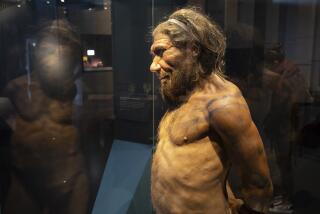The Mating of Myth and Science : EASTER ISLAND: The Mystery Solved <i> by Thor Heyerdahl (Random House: $24.95; 255 pp; 0-394-57906-2) </i>
The work of Thor Heyerdahl, the famed Norwegian explorer and archeologist, touches impulses deep within us. Maybe it’s the universal desire to know our origins, the sources of our myths. Or the need to understand how a culture is born, and how its traditions survive.
As a little boy, I cradled Heyerdahl’s books, “Kon Tiki” and “The Ra Expedition,” to my chest, dreaming about exploits in faraway lands. His daring ocean voyages on reed and balsa boats weren’t comic-book antics but the stuff of real life.
Heyerdahl’s new book, “Easter Island: The Mystery Solved,” stirred similar feelings--even to a skeptical adult no longer held captive by childhood fantasies. It roused my imagination like a good novel.
“Easter Island” is a historical account of the tiny tourist island off the Chilean coast famed for its giant stone heads and statues. But beyond the bus tours and the gift shops, the origins of the island people and their curious art have baffled scientists since the 18th Century.
One of the biggest mysteries has surrounded the colossal statues that circled the island like sentries. How had prehistoric stonemasons moved the huge figures--some as high as five-story buildings and weighing 40 tons--from the quarries to sacred sites miles away?
Researchers scoffed at the island legends: that gods and shamans made the statues “walk” to their homes. Heyerdahl had doubts, too--until he heard from an excited engineer. The man urged Heyerdahl to try an experiment proving the stone giants really had moved, upright at their bases, along the volcanic-island roads.
Another riddle involved the Easter Island natives. No other Pacific island was inhabited by a mixed race of dark Asiatics and a strange, red-haired people with fair skin. According to legend, the ears of the white people stretched grotesquely to their shoulders.
“The problem of the original settling of Polynesia was one of the greatest whodunits of all times,” writes Heyerdahl. “Their route covered thousands of miles of roaring ocean, so no footprints remained.”
The physical characteristics of the islanders and their language showed some influence of Polynesian culture, but what explained the presence of the strange islanders with Caucasian facial features?
Heyerdahl noticed that the stone tombs, reed huts and cave-like dwellings of Easter Island resembled the work of pre-Incans in South America. Motifs in religious art also had an eerie connection with art carved by Latin American peoples.
Earlier in his career, Heyerdahl defied conventional belief that ancient peoples had not sailed the oceans on reed boats. Now he set out to show cynics that Easter Island was settled by a prehistoric tribe from South America.
In Heyerdahl’s first expedition to Easter Island in 1955, his crew unearthed several “missing links.” They dug up art never before seen on any Pacific island. The statues they found were almost identical to pre-Incan art carved in the Andes.
A short while later, Heyerdahl made another shocking discovery. At the suggestion of a local priest, the scientists dug at a cliff-side trench, the fabled site of a mythical battle in which the red-haired people were massacred.
To the thrill of the islanders, the researchers found an ancient funeral pyre. The ashes and charred wood were carbon-dated AD 1676--matching an unofficial genealogy compiled by the priest that stretched back 12 generations. The red-haired islanders had indeed lived that long ago, as legend told.
Four years ago, Heyerdahl and a team of scientists from Chile and Czechoslovakia found even more evidence confirming local legend and Heyerdahl’s hypothesis about South America. “Tradition had triumphed over theory,” he writes.
Some of the ground in this book was covered in “The Art of Easter Island,” a 1975 work by Heyerdahl. But then he gets to his archeological sleuthing and his new discoveries. Readers will be hooked on the text and the vivid color photographs.
To our benefit, Heyerdahl explores the island with a scientist’s passion for facts, a shaman’s respect for tradition--and a little boy’s imagination.
More to Read
Sign up for our Book Club newsletter
Get the latest news, events and more from the Los Angeles Times Book Club, and help us get L.A. reading and talking.
You may occasionally receive promotional content from the Los Angeles Times.






